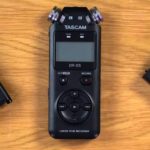
Picture this: It’s your big break, and you’re about to step up into the DJ booth with your dream set, ready to rock the place. Then you realise that the venue’s promised set recording facilities haven’t materialised!
Sadly it looks the stunning two-hour beatmatched, harmonically tuned masterpiece that you’ve been preparing for weeks and planning to record is only going to live on in the minds of your audience…
“Hang on, I’ll just use the record function on my DJ software!” you might think. Well, I for one don’t trust my laptop to record and work flawlessly when DJing. And there are other situations where this might not cut it, too: maybe you’re DJing a mix of digital and analogue, or you have live percussion, or you want to capture crowd noise, or MCing…
Luckily, it turns out that your iPhone can rescue you… but you’ll need to have pre-planned it.
What hardware you’ll need
The iPhone can already record, straight from the built-in microphone. But that’s hardly going to be good enough for recording a DJ set. We want a line output from the mixer directly into our iDevice. For this we’ll need an additional interface of some kind. Be warned though your choice of interface will vary depending on the version of your iDevice! With the arrival of the first iPad in 2010, Apple phased out stereo analog input (via the 30pin connector). This means that you can only achieve a stereo digital input on iPhone 4, iPad or 4th Generation iPod Touch by using a USB audio interface with a built in analog-to-digital converter (ADC).
30-pin connnector devices
These plug in to the bottom of your iPhone, and offer the best stereo quality – but are harder to get going with software that is different to that provided with them or designed to use them. The best choice would be the Blue Microphones Mikey Digital microphone. The Mikey is great for field recording but also has a stereo line input via a 3.5mm input jack.

It can be set up with automatic or manual gain control so you can ensure your mixer output doesn’t clip at louder volumes. Retailing at $99, another benefit of this device is that it is compatible with most recording apps on iOS.
(This is actually the third generation of the Mikey product line, for recent devices; there is an older version for earlier devices including iPod Nano and iPod Classic. A compatibility chart helps you decide on which is more appropriate for your device.)
Alternatively, if you don’t ever think you’re going to want a microphone, you could look at GuitarJack. While this feeds into its own control panel that is built in to some specialist guitar apps, there’s also a “hack” that lets you use it with most third-party apps. (You set everything up in its control panel, quit, open the third-party app and all settings should be retained.)
By the way, another device we found – Line6’s MobileIn – looked good too, but nobody seemed to be able to get to work with any app other than the company’s own guitar modelling software – making it no good for recording DJ sets, unfortunately.
Recording direct with an adaptor lead
The second method is to buy an adaptor lead that attenuates the stereo line-in signal from your DJ mixer and feeds it through the 1/8″ headphone/microphone adaptor on the top of your iPhone or iPod Touch. This lead works with a whole load of other smartphones too…
While you may not get the same quality (we haven’t tried it, but we have found the lead that does it; KV Connection sells it), it may be plenty good enough.
Update: Using the headphone jack would only give you a mono audio input. The socket has four conductors, left and right stereo output, one ground and one for mono mic input.
A bonus here is that judging by the compatibility chart on KV’s website, this lead works with a whole load of other smartphones too. And of course, as you’re just feeding into the iPhone/iPod Touch’s built-in external microphone input (didn’t you know the headphones output was also a mic input? You do now…), there’s no problem getting it to work with any recording software.
Software for the job
Your next job is deciding what to actually do your recording on. If you’re underwhelmed by the iPhone’s built-in Voice Memo app, you could half-way house it with one any of the many iPhone sample recording apps, one of our favourite being FiRe 2.
Alternatively, you could go the whole hog with a specialist music app (such as Apple’s own GarageBand). If you had also opted for a Mikey interface, you could then record crowd and DJ set, for mixdown later, as we suggested above.
And that’s it! You’re all set up to capture your sets, potentially with crowd noises and all, to keep forever.
Conclusion

The aim of this piece was to investigate whether it’s feasible to whip your iPhone out and record your DJ set, straight from the mixer.
Whether you choose to use a simple audio adaptor or go with a proper line-in solution, it turns out that it is; however, once you’ve invested in one of these solutions (you’re looking at anything from US$30 for the lead up to closer to US$170 for GuitarJack), you may have been better off going for a cheap dedicated hardware recorder.
Then at least if your phone rings while you are DJing, you can at least try and take the call…
Do you record your mixes with your mobile device? Have you got a preferred recording app or hardware solution? Please share your thoughts in the comments.








